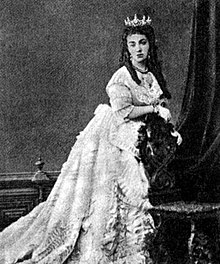Refia Sultan (daughter of Abdulmejid I)
| Refia Sultan | |
|---|---|
 | |
| Born | 7 February 1842 Beşiktaş Palace, Constantinople, Ottoman Empire (now Istanbul, Turkey) |
| Died | 4 January 1880 (aged 37) Defterdarburnu Palace, Istanbul, Ottoman Empire |
| Burial | New Mosque, Istanbul |
| Spouse | Mahmud Edhem Pasha
(m. 1857; her d. 1880) |
| Dynasty | Ottoman |
| Father | Abdulmejid I |
| Mother | Gülcemal Kadın |
| Religion | Sunni Islam |
Refia Sultan (Ottoman Turkish: رفعیه سلطان; 7 February 1842 – 4 January 1880) was an Ottoman princess, daughter of Sultan Abdulmejid I and his sixth wife Gülcemal Kadın. She was full sister of Sultan Mehmed V of the Ottoman Empire.
Early life[]
Refia Sultan was born on 7 February 1842 in the Beşiktaş Palace. Her father was Sultan Abdulmejid I, and her mother was Gülcemal Kadın. She was the seventh daughter of her father and second child of her mother. She had a elder sister Fatma Sultan, one year elder then her and a younger brother Mehmed V, two years younger then her.[1][2][3] Upon the death of her mother in 1851, she and her siblings were adopted by Abdulmejid's first wife, Servetseza Kadın.[4][5]
In accordance with the custom, Refia Sultan began to take lessons in the Quran in 1847, together with her sisters Fatma, and Cemile Sultan, and brothers Murad V and Abdul Hamid II. Her education continued ever after marriage. She learned French and Persian languages. She also learned French and Western music.[6]
Marriage[]
On 22 February 1854,[7] when Refia was twelve, Abdulmejid betrothed her to Mahmud Edham Pasha, the son of Mehmed Ali Pasha. Mehmed Ali Pasha had himself been married to Refia's aunt, Adile Sultan, with whom he had a daughter named Hayriye Hanımsultan.[8] Baronne Durand de Fontmagne, who lived in Istanbul for a year and a half in 1858-9 following the Crimean war, was shown the gifts about to be sent to Refia Sultan before her marriage. She noted that these included various preserves in 'not less than five hundred pots of very fine Dresden China'.[9][10] The marriage took place on 21 July 1857, at the Topkapi Palace, and the couple were given a palace located at the Defterdarburnu as their residence.[11]
She remained childless.[2] The marriage turned out to be unhappy. It is understood from the letters that she wrote to her brothers that Edhem Pasha had a flirtatious behaviour. On the other hand, Edhem Pasha was not happy with this marriage because of the illness of Refia, and other disagreements between the two of them.[12]
Character[]
The generous personality of Refia was more apparent on special occasions such as festivals. During the Eid-al-Adha, she gave rams and sheep to some relatives, servants. The help and generosity of Refia Sultan attracted a great deal of attention. As a matter of fact, due to her aid to the soldiers who were injured in the Russo-Turkish War (1877-78) and to the Muslim immigrants who had to leave their homes after the war. She was awarded with the order of charity by her half-brother Sultan Abdul Hamid.[13]
In addition to her benevolence and generosity, Refia also was equally grand with her lavishness. Spending more than the income of the palace women in the 19th century and especially during the reign of her father Abdulmejid became almost a tradition. She was also raised in this period and was influenced by the passion of shopping and fashion of other women in the palace. In fact, this was the result and necessity of a new lifestyle similar to that in the West. As a matter of fact, she ordered harnesses from Paris and her clothing needs.[14]
The princess ordered goods and clothes from both Istanbul and France through her French teacher, Maria Tirard. Other foreign women, such as Tirard, who communicated with the palace, not only ensured the spread of western culture among the women of the palace but also provoked them to follow Western fashion.[15]
Death[]
In 1875, Refia developed Ovarian cyst.[16] She died at the age of thirty seven on 4 January 1880, following a long illness, and several operations. She is buried in the mausoleum of the imperial ladies at the New Mosque, Istanbul.[2][17][18]
Honour[]
- Order of Charity, 1st class, 1877-78[13]
See also[]
Ancestry[]
| showAncestors of Refia Sultan (daughter of Abdulmejid I) |
|---|
References[]
- ^ Uluçay 2011, p. 220.
- ^ Jump up to: a b c Brookes 2010, p. 288.
- ^ Kolay 2017, p. 679.
- ^ Uluçay 2011, p. 203.
- ^ Kolay 2017, p. 680.
- ^ Kolay 2017, p. 680-81.
- ^ Kolay 2017, p. 681.
- ^ Simonian, Hovann (January 24, 2007). The Hemshin: History, Society and Identity in the Highlands of Northeast Turkey. Routledge. p. 104. ISBN 978-1-135-79830-7.
- ^ McWilliams, Mark (July 1, 2012). Celebration: Proceedings of the Oxford Symposium on Food and Cookery 2011. Oxford Symposium. p. 155. ISBN 978-1-903-01889-7.
- ^ Isin, Mary (January 8, 2013). Sherbet and Spice: The Complete Story of Turkish Sweets and Desserts. I.B.Tauris. pp. 110–11. ISBN 978-1-848-85898-5.
- ^ Sakaoğlu, Necdet (2008). Bu mülkün kadın sultanları: Vâlide sultanlar, hâtunlar, hasekiler, kadınefendiler, sultanefendiler. Oğlak Yayıncılık. pp. 613–18. ISBN 978-9-753-29623-6.
- ^ Kolay 2017, p. 682.
- ^ Jump up to: a b Kolay 2017, p. 683.
- ^ Kolay 2017, p. 683-84.
- ^ Kolay 2017, p. 684.
- ^ Kolay 2017, p. 685-86.
- ^ Uluçay 2011, p. 221.
- ^ Kolay 2017, p. 686.
Sources[]
- Brookes, Douglas Scott (2010). The Concubine, the Princess, and the Teacher: Voices from the Ottoman Harem. University of Texas Press. ISBN 978-0-292-78335-5.
- Kolay, Arif (2017). Osmanlı Saray Hayatından Bir Kesit: Ali Akyıldız ve Mümin ve Müsrif Bir Padişah Kızı Refia Sultan.
- Uluçay, Mustafa Çağatay (2011). Padişahların kadınları ve kızları. Ankara, Ötüken.
- Daughters of Ottoman sultans
- 1842 births
- 1880 deaths
- 19th-century Ottoman royalty
- 19th-century women of the Ottoman Empire

